Genre: Beat-‘Em-Up Developer: Rare Publisher: Tradewest Players: 1-2 Released: 1991
You are Rash (or Zitz, dependent upon whether or not you’re holding the second-player controller) and you are a Battletoad. Somewhat akin to a Teenage Mutant Ninja Turtle, you are a green, mean, ass-kicking machine. Unfortunately, the Dark Queen of Ragnarok has been up to some no good, and now it is up to you to save your brother Pimple, and the Princess Angelica. To do so, you’ll have to trek through twelve of the most difficult scenarios around. Are you up to the challenge?
Many gamers who owned an NES were up to the challenge, as this game was a smash hit for that console. It pushed the limits of the NES hardware, and while it hasn’t aged nearly as well as its Genesis counterpart, it is still mighty impressive to see in motion. Battletoads was also partially responsible for propelling Rare into the top spectrum of game developers. It was a beginning to a series that would see sequels, merchandise, and even an ill-fated animated series. But how does Battletoads for the Genesis fare compared to the 8-bit wonder? Instead of being a director’s cut or adding in anything new, Rare disappointingly gave us the same game with a few enhancements. In doing this, it ultimately missed out on an enormous opportunity.
Battletoads is a beat-’em-up. And like all other games of the genre, criticisms or praise should be strongly based upon gameplay. Because it is a port of a NES title, only two buttons are required to play. There’s attack (which mostly means “punch”) and jump. There are certainly a good number of games out there that are able to pull off a complex brawler using a similar control scheme, but with Battletoads, what you see is what you get. The only other options besides “attack” and “jump” are picking up and using weapons and committing a “dash attack.” Another big aspect of games in this genre is variety in enemies, and while there does seem to be a decent amount of enemy types here, they tend to all feel the same. Punch them four times, and then go for the finishing shot. This can become a little repetitive. What keeps Battletoads from feeling stale is its variety of gameplay styles. The game occasionally throws a few specific change-of-view battles at you, and it features several “speed” levels in which you basically attempt to survive a large amount of oncoming obstacles. I found these very welcomed changes in pace/style, but they could also be extremely frustrating.
The largest problem I have with Battletoads is with its difficulty. This game is hard, very hard, which some may see as a positive. I, on the other hand, don’t enjoy having to buy new controllers every time I play that damned third level. On a side note: I actually prefer the Genesis control to that of the NES (so try not to take it out on that poor controller’ it’s not his fault). The speed levels specifically feel unfair in their relentless difficulty, and the game often pushes memorization of obstacles over actual skill. Even so, gamers hardcore or skilled enough to push through the difficulty will find an extremely rewarding game. After spending nearly four relentless hours trying to complete it, I was extremely pleased (and I’ll say it – freaking proud) of myself after beating the game. And looking back on it, I had lots of fun. I just can’t picture a casual gamer feeling the same.
If you can manage the difficulty, the levels are as diverse as the gameplay styles. You’ll brawl through mountains, tunnels, arctic caverns, waves, and other locations that oftentimes just feel ridiculous (yet fun). Within most levels, weapons are available. These help break up the monotonous gameplay a bit and can help finish off an enemy in no time. The game can also be played with a second player, and while this can be great fun, the player basically needs to be as skilled as you are in order to complete the game.
The graphics in Battletoads are good enough, but nowhere near as ground-breaking as the NES original’s. The character sprites are colorful, yet a bit pixilated. Environments take the largest leap in graphical quality, yet for some reason Rare uses a lot of bland colors. Using the Genesis’s limited color palette as an excuse for this is unacceptable, seeing as a couple of stage backgrounds look absolutely fantastic. The game was released in 1993, well into the Genny’s life cycle, and Rare could have easily produced much better graphics.
The audio, on the other hand, is all over the place. Simple “thumps” and “cracks” are used when fighting, but nothing here is too special; however, the soundtrack, whether you enjoy it or not, is very memorable. You WILL have the theme song stuck in your head when you finish playing, which is always a success for the developer. The sounds, like the graphics, are a huge upgrade from the NES original. Still, much better use has been made of the Genesis’ sound capabilities, and again, there’s really no excuse for this.
Battletoads has a lot going for it. It’s challenging, fun, and controls well. There is though, a disappointing feeling of “what could have been,” as Rare had two years to fix it’s fan-proclaimed classic into an excellent Genesis game. Instead, what we received is too similar to its NES counterpart. While the expected upgrades to the sound and graphics were made, adjustments and additions were completely overlooked. Battletoads for the Genesis thusly feels dated. And when sitting next to superior games like Streets of Rage, the game becomes less attractive. If you can find it cheap (and don’t already own it for the NES) I would definitely recommend it as a purchase. It’s just not worth going out of your way for.
SCORE: 7 out of 10


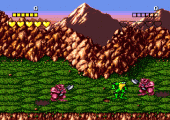
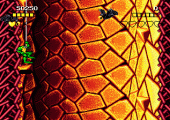
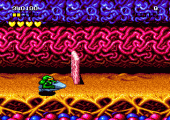
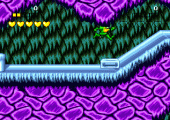
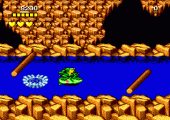
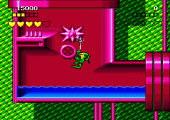
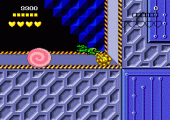
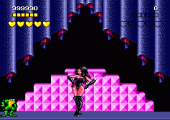
Recent Comments